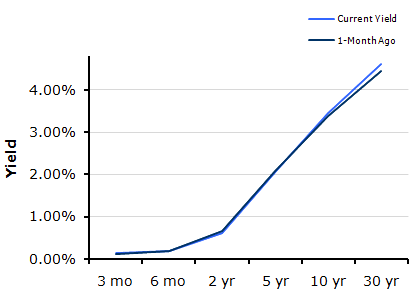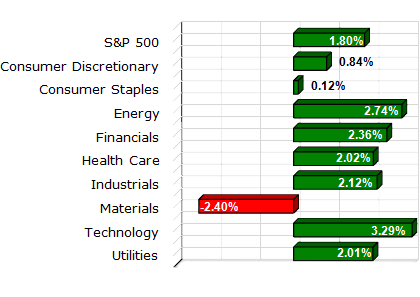
Market Commentary by Scott J. Brown, Ph.D., Chief Economist

The economic data were mixed, but generally consistent with a continued recovery. Housing starts fell in December, but building permits (which are reported more accurately than starts) rose sharply (partly reflecting the usual volatility in the multi-family sector). Existing home sales were stronger than anticipated in December, but these represent closings (and hence, lag somewhat). Higher mortgage rates may have dampened housing activity into the new year. The Index of Leading Economic Indicators posted another strong gain in December, boosted by the rise in building permits.
The stock market seemed to struggle with good news (earnings reports and the economic data releases). Bond yields rose, pressured by the economic data and by a disappointing 10-year TIPS auction. Crude oil prices backed down somewhat following reports of higher inventories.
Next week, the focus will be on the FOMC meeting and the advance GDP report. However, not much is expected from the Fed. Policymakers are widely expected to leave short-term interest rates unchanged and continue the asset purchase program ($600 billion in long-term Treasuries between November 2010 and June 2011). The wording of the Fed’s economic assessment should be a little brighter. There’s always a lot of uncertainty in the government’s advance estimate of Gross Domestic Product. Inflation-adjusted consumer spending (70% of GDP) appears likely to have risen at an annual rate of more than 4%. A slower rate of inventory accumulation will subtract from overall GDP growth. However, growth in exports picked up and imports fell, which will add to the headline growth figure.
Indices
| Last | Last Week | YTD return % | |
| DJIA | 11822.8 | 11731.9 | 2.12% |
| NASDAQ | 2704.29 | 2735.29 | 1.94% |
| S&P 500 | 1280.26 | 1283.76 | 1.80% |
| MSCI EAFE | 1672.17 | 1692.31 | 0.84% |
| Russell 2000 | 778.08 | 800.65 | -0.71% |
Consumer Money Rates
| Last | 1-year ago | |
| Prime Rate | 3.25 | 3.25 |
| Fed Funds | 0.18 | 0.10 |
| 30-year mortgage | 4.80 | 5.07 |
Currencies
| Last | 1-year ago | |
| Dollars per British Pound | 1.590 | 1.628 |
| Dollars per Euro | 1.347 | 1.412 |
| Japanese Yen per Dollar | 82.880 | 91.210 |
| Canadian Dollars per Dollar | 0.998 | 1.047 |
| Mexican Peso per Dollar | 12.059 | 12.762 |
Commodities
| Last | 1-year ago | |
| Crude Oil | 88.86 | 77.62 |
| Gold | 1352.13 | 1112.15 |
Bond Rates
| Last | 1-month ago | |
| 2-year treasury | 0.62 | 0.66 |
| 10-year treasury | 3.45 | 3.39 |
| 10-year municipal (TEY) | 5.54 | 5.28 |
Treasury Yield Curve – 1/21/2011

S&P Sector Performance (YTD) – 1/21/2011

Economic Calendar
| January 25th | — | Consumer Confidence (January) FOMC Policy Meeting Begins State of the Union Address |
| January 26th | — | New Home Sales (December) FOMC Policy Decision |
| January 27th | — | Initial Claims (week ending January 22nd) Durable Goods Orders (December) Pending Home Sales Index (December) |
| January 28th | — | Real GDP (4Q11, advance estimate) Employment Cost Index (4Q11) Consumer Sentiment (January) |
| January 31st | — | Personal Income and Spending (December) |
| February 1st | — | ISM Manufacturing Index (January) Motor Vehicle Sales (January) |
| February 3rd | — | ISM Non-Manufacturing Index (January) Bernanke Q&A to National Press Club |
| February 21st | — | Presidents Day (markets closed) |
| March 15th | — | FOMC Meeting |
Important Disclosures
Past performance is not a guarantee of future results. There are special risks involved with global investing related to market and currency fluctuations, economic and political instability, and different financial accounting standards. The above material has been obtained from sources considered reliable, but we do not guarantee that it is accurate or complete. There is no assurance that any trends mentioned will continue in the future. While interest on municipal bonds is generally exempt from federal income tax, it may be subject to the federal alternative minimum tax, state or local taxes. In addition, certain municipal bonds (such as Build America Bonds) are issued without a federal tax exemption, which subjects the related interest income to federal income tax. Investing involves risk and investors may incur a profit or a loss.
US government bonds and treasury bills are guaranteed by the US government and, if held to maturity, offer a fixed rate of return and guaranteed principal value. US government bonds are issued and guaranteed as to the timely payment of principal and interest by the federal government. Treasury bills are certificates reflecting short-term (less than one year) obligations of the US government.
Commodities trading is generally considered speculative because of the significant potential for investment loss. Markets for commodities are likely to be volatile and there may be sharp price fluctuations even during periods when prices overall are rising. Specific sector investing can be subject to different and greater risks than more diversified investments.
Tax Equiv Muni yields (TEY) assume a 35% tax rate on triple-A rated, tax-exempt insured revenue bonds.
![]() Material prepared by Raymond James for use by its financial advisors.
Material prepared by Raymond James for use by its financial advisors.
The information contained herein has been obtained from sources considered reliable, but we do not guarantee that the foregoing material is accurate or complete. Data source: Bloomberg, as of close of business January 20th, 2010.
©2011 Raymond James Financial Services, Inc. member FINRA / SIPC.


